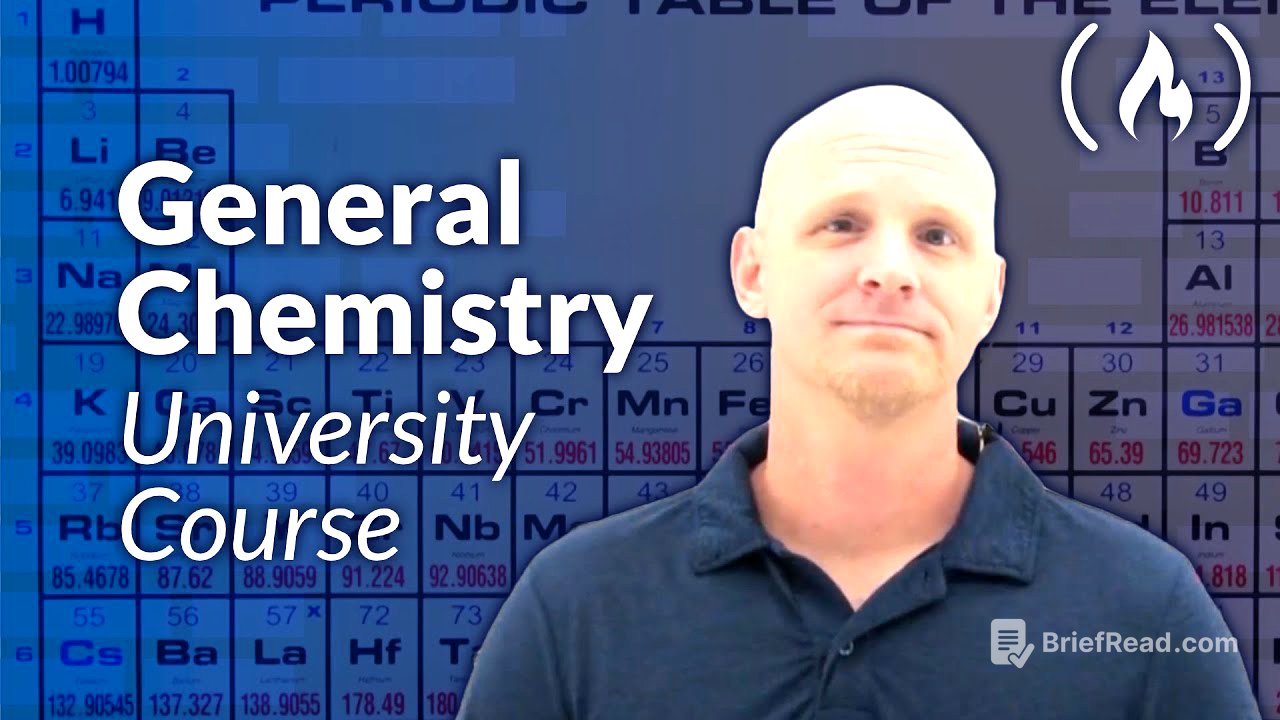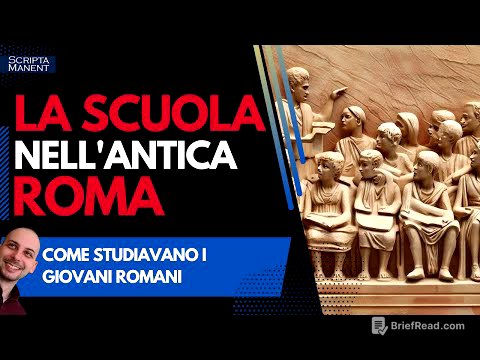TLDR;
This comprehensive general chemistry course covers a wide range of topics, from the fundamental building blocks of matter to the principles governing chemical reactions. Key areas include atomic structure, bonding, thermodynamics, equilibrium, and the properties of matter in its various phases. The course also introduces essential terminology, measurement techniques, and classifications of matter, providing a solid foundation for future scientific studies.
- Matter and its properties
- Classifying matter: elements, compounds, mixtures
- Chemical and physical properties and changes
- Scientific notation and significant figures
- Units and conversions
- Atomic structure and the periodic table
- Chemical reactions and equations
Introduction to General Chemistry [0:00]
This course provides a comprehensive introduction to general chemistry, covering basic building blocks of matter to the principles governing chemical reactions. The playlist will span two semesters of college general chemistry, presented in roughly 90 lessons across 20 chapters. In addition to general chemistry, the channel also offers master courses for high school and college science courses, as well as DAT, MCAT, and OAT prep.
Matter - Definitions and Classifications [0:37]
Matter is defined as anything that has mass and occupies space, composed of tiny particles called atoms. There are approximately 118 different types of atoms, known as elements, which make up everything in the universe. Matter exists in three major phases: solid, liquid, and gas. Solids have a definite shape and volume, liquids have a definite volume but no definite shape, and gases have neither. At the atomic level, solids are typically crystalline with atoms arranged in repeating patterns, while liquids are more random with flowing atoms, and gases have widely spread atoms moving rapidly.
Elements, Compounds, Pure Substances, and Mixtures [5:26]
Matter is classified into elements and compounds. Elements are fundamental types of atoms, or substances made of only one type of atom, such as sodium metal. Compounds are substances made of multiple elements, like sodium chloride (table salt), which contains sodium and chlorine atoms in a 1:1 ratio. Some elements, like nitrogen, oxygen, and hydrogen, exist as diatomic molecules in their elemental form. Pure substances consist of only one element or one compound, such as pure oxygen gas or water. Mixtures, on the other hand, are combinations of multiple substances that are not chemically bonded, such as air (a mixture of nitrogen and oxygen) or salt water (a mixture of salt and water).
Homogeneous vs. Heterogeneous Mixtures [12:06]
Mixtures are further classified as homogeneous or heterogeneous. Homogeneous mixtures, also known as solutions, have a uniform composition throughout, meaning samples taken from any part of the mixture will have the same amount of each component. Air is an example of a homogeneous mixture. Heterogeneous mixtures do not have a uniform composition, with different samples containing varying amounts of each component. A salad or a supreme pizza are examples of heterogeneous mixtures. Salt water can be either homogeneous or heterogeneous depending on whether the salt is fully dissolved or if excess salt settles at the bottom.
Chemical vs. Physical Properties and Changes [16:55]
Properties of matter are classified as either chemical or physical. Chemical properties describe how a substance changes into a different substance, such as flammability, which is associated with the chemical change of combustion. Physical properties, such as melting point, describe characteristics that can be observed without changing the substance's chemical identity. Physical changes, like tearing paper or melting ice, do not convert one substance into another, while chemical changes, like burning paper or rusting a nail, do.
Intensive vs. Extensive Properties, Scientific Notation [23:04]
Properties are also classified as intensive or extensive. Intensive properties, such as melting point and density, do not depend on the size of the sample, while extensive properties, such as mass and volume, do. Density, although defined as mass divided by volume, is an intensive property. Scientific notation is a convenient way to express very large or very small numbers, using a coefficient and a power of 10. For numbers greater than one, the power of 10 is positive, and for numbers less than one, the power of 10 is negative.
Significant Figures [28:28]
Significant figures indicate the precision with which a number is known. Non-zero numbers are always significant, while zeros have specific rules. Zeros at the beginning of a number are never significant, zeros at the end are significant if they are to the right of the decimal, and zeros in the middle of a number are always significant. When multiplying or dividing, the answer should have the same number of significant figures as the number with the fewest significant figures. When adding or subtracting, the answer should be rounded to the same decimal place as the least precise term.
Precision vs. Accuracy, Units and Conversions [44:59]
Precision refers to the repeatability of a measurement, while accuracy refers to how close a measurement is to the true value. It is possible to have precise measurements that are not accurate, and vice versa. The metric system and SI units are based on powers of 10, using prefixes like kilo, centi, and milli to denote different magnitudes. Conversions between units require conversion factors, which are equalities between different units. When converting units with exponents, such as cubic meters to cubic centimetres, the entire conversion factor must be raised to the appropriate power.
Metric Prefixes and Conversions [48:11]
The metric system uses prefixes to denote powers of 10, such as tera (10^12), giga (10^9), mega (10^6), kilo (10^3), centi (10^-2), milli (10^-3), micro (10^-6), nano (10^-9), pico (10^-12), femto (10^-15), and atto (10^-18). When performing conversions, it is important to use the correct power of 10 and to ensure that the units cancel properly. When converting between systems, such as meters to feet, a crossover conversion factor is needed.
Temperature Scales and Density [50:50]
Temperature can be measured in Celsius, Fahrenheit, or Kelvin. The Kelvin scale is the SI unit and has an absolute zero. Conversions between Celsius and Kelvin are straightforward, while conversions involving Fahrenheit require more complex formulas. Density is an intensive property defined as mass divided by volume. It can be used to identify substances and can be manipulated algebraically to solve for mass or volume if the other two variables are known.
Fathers of Atomic Theory [1:17:37]
Dalton proposed that all matter is made of atoms, atoms of one element are different from those of other elements, compounds are formed by combining atoms of different elements, and atoms are not created or destroyed in chemical reactions. JJ Thompson discovered the electron and its mass-to-charge ratio. Robert Milikan determined the mass and charge of the electron. Ernest Rutherford discovered the nucleus through the gold foil experiment, revealing that atoms consist mostly of empty space with a small, dense, positively charged nucleus.
Subatomic Particles and Isotope Symbols [1:22:10]
Protons have a +1 charge, electrons have a -1 charge, and neutrons are neutral. The actual charge of an electron is -1.602 x 10^-19 coulombs, and the charge of a proton is +1.602 x 10^-19 coulombs. Protons and neutrons both weigh approximately 1 amu, while electrons weigh about 1/1841 amu. Isotope symbols include the atomic number (number of protons), mass number (protons + neutrons), and charge. The number of neutrons can be found by subtracting the atomic number from the mass number.
Elements, Isotopes and Atomic Mass [1:29:39]
Elements can exist as different isotopes, which have the same number of protons but different numbers of neutrons. The atomic mass listed on the periodic table is a weighted average of the masses of all naturally occurring isotopes of that element. To calculate the atomic mass, multiply the mass of each isotope by its relative abundance (as a decimal) and sum the results. Some elements, like bromine and chlorine, have two major isotopes with significant abundances, while others, like oxygen and carbon, have one dominant isotope.
Periodic Table and Classifying Elements [1:38:39]
The periodic table is organised into groups (columns) and periods (rows). Elements in the same group have similar chemical properties. The periodic table can be divided into metals, non-metals, and metalloids (or semi-metals). Metals are typically lustrous, malleable, ductile, and good conductors of heat and electricity. Non-metals are generally poor conductors. Metalloids have properties intermediate between metals and non-metals. Certain groups have specific names, such as the alkali metals (group 1), alkaline earth metals (group 2), halogens (group 7), and noble gases (group 8). Transition metals are located in the middle of the periodic table, and lanthanides and actinides are found at the bottom.
Types of Compounds and Naming Ionic Compounds [1:46:41]
Ionic compounds are generally formed between a metal and a non-metal, while molecular compounds are formed between two non-metals. Acids are compounds that start with hydrogen (H) in their formula. Binary acids consist of hydrogen and one other element, while oxyacids contain hydrogen, oxygen, and another element. When naming ionic compounds, the cation is named first, followed by the anion with an "ide" ending. If the cation can have multiple charges, a Roman numeral is used to indicate the charge.
Diatomic Elements and Pure Substances [6:11]
Certain elements, such as nitrogen, oxygen, fluorine, chlorine, bromine, iodine, and hydrogen, exist as diatomic molecules in their elemental form. A pure substance consists of only one element or one compound. A mixture is a combination of multiple substances. Homogeneous mixtures have a uniform composition throughout, while heterogeneous mixtures do not.
Classifying Matter and Properties [16:40]
Matter can be classified based on its properties. Chemical properties describe how a substance changes into a different substance, while physical properties can be observed without changing the substance's chemical identity. Intensive properties do not depend on the size of the sample, while extensive properties do.
Significant Figures and Mathematical Operations [37:14]
When performing mathematical operations with significant figures, the rules differ for multiplication/division and addition/subtraction. For multiplication and division, the answer should have the same number of significant figures as the number with the fewest significant figures. For addition and subtraction, the answer should be rounded to the same decimal place as the least precise term. When a calculation involves both multiplication/division and addition/subtraction, the significant figures should be adjusted at each step.
Significant Figures and Zeros [32:24]
Zeros in a number can be significant or not, depending on their position. Zeros at the beginning of a number are never significant. Zeros at the end of a number are significant if they are to the right of the decimal, but not significant if they are to the left of the decimal. Zeros in the middle of a number are always significant. Scientific notation can be used to clarify the significance of zeros.
Significant Figures in Conversions and Precision vs. Accuracy [1:03:39]
Conversion factors do not affect the number of significant figures in a calculation, as they are considered exact. Accuracy refers to how close a measurement is to the true value, while precision refers to the repeatability of a measurement. It is possible to have precise measurements that are not accurate, and vice versa.
Units and the Metric System [47:37]
The metric system and SI units are based on powers of 10, using prefixes like kilo, centi, and milli to denote different magnitudes. The SI units for length, mass, time, temperature, volume, energy, and pressure are meter, kilogram, second, Kelvin, cubic meter, joule, and Pascal, respectively. However, in chemistry, grams, liters, and atmospheres are often used instead of the corresponding SI units.
Units and Conversions [56:19]
When performing conversions, it is important to use the correct power of 10 and to ensure that the units cancel properly. When converting between systems, such as meters to feet, a crossover conversion factor is needed. When dealing with area or volume, the conversion factor must be squared or cubed, respectively. Temperature conversions between Celsius, Fahrenheit, and Kelvin require specific formulas.
Temperature Scales and Density [1:09:27]
Temperature can be measured in Celsius, Fahrenheit, or Kelvin. The Kelvin scale is the SI unit and has an absolute zero. Conversions between Celsius and Kelvin are straightforward, while conversions involving Fahrenheit require more complex formulas. Density is an intensive property defined as mass divided by volume. It can be used to identify substances and can be manipulated algebraically to solve for mass or volume if the other two variables are known.
Atomic Theory and Structure [1:17:37]
Dalton proposed that all matter is made of atoms, atoms of one element are different from those of other elements, compounds are formed by combining atoms of different elements, and atoms are not created or destroyed in chemical reactions. JJ Thompson discovered the electron and its mass-to-charge ratio. Robert Milikan determined the mass and charge of the electron. Ernest Rutherford discovered the nucleus through the gold foil experiment, revealing that atoms consist mostly of empty space with a small, dense, positively charged nucleus.
Subatomic Particles and Isotope Symbols [1:22:10]
Protons have a +1 charge, electrons have a -1 charge, and neutrons are neutral. The actual charge of an electron is -1.602 x 10^-19 coulombs, and the charge of a proton is +1.602 x 10^-19 coulombs. Protons and neutrons both weigh approximately 1 amu, while electrons weigh about 1/1841 amu. Isotope symbols include the atomic number (number of protons), mass number (protons + neutrons), and charge. The number of neutrons can be found by subtracting the atomic number from the mass number.
Elements, Isotopes and Atomic Mass [1:29:39]
Elements can exist as different isotopes, which have the same number of protons but different numbers of neutrons. The atomic mass listed on the periodic table is a weighted average of the masses of all naturally occurring isotopes of that element. To calculate the atomic mass, multiply the mass of each isotope by its relative abundance (as a decimal) and sum the results. Some elements, like bromine and chlorine, have two major isotopes with significant abundances, while others, like oxygen and carbon, have one dominant isotope.
Periodic Table and Classifying Elements [1:38:39]
The periodic table is organised into groups (columns) and periods (rows). Elements in the same group have similar chemical properties. The periodic table can be divided into metals, non-metals, and metalloids (or semi-metals). Metals are typically lustrous, malleable, ductile, and good conductors of heat and electricity. Non-metals are generally poor conductors. Metalloids have properties intermediate between metals and non-metals. Certain groups have specific names, such as the alkali metals (group 1), alkaline earth metals (group 2), halogens (group 7), and noble gases (group 8). Transition metals are located in the middle of the periodic table, and lanthanides and actinides are found at the bottom.
Types of Compounds and Naming Ionic Compounds [1:46:41]
Ionic compounds are generally formed between a metal and a non-metal, while molecular compounds are formed between two non-metals. Acids are compounds that start with hydrogen (H) in their formula. Binary acids consist of hydrogen and one other element, while oxyacids contain hydrogen, oxygen, and another element. When naming ionic compounds, the cation is named first, followed by the anion with an "ide" ending. If the cation can have multiple charges, a Roman numeral is used to indicate the charge.
Diatomic Elements and Pure Substances [6:11]
Certain elements, such as nitrogen, oxygen, fluorine, chlorine, bromine, iodine, and hydrogen, exist as diatomic molecules in their elemental form. A pure substance consists of only one element or one compound. A mixture is a combination of multiple substances. Homogeneous mixtures have a uniform composition throughout, while heterogeneous mixtures do not.
Classifying Matter and Properties [16:40]
Matter can be classified based on its properties. Chemical properties describe how a substance changes into a different substance, while physical properties can be observed without changing the substance's chemical identity. Intensive properties do not depend on the size of the sample, while extensive properties do.
Significant Figures and Mathematical Operations [37:14]
When performing mathematical operations with significant figures, the rules differ for multiplication/division and addition/subtraction. For multiplication and division, the answer should have the same number of significant figures as the number with the fewest significant figures. For addition and subtraction, the answer should be rounded to the same decimal place as the least precise term. When a calculation involves both multiplication/division and addition/subtraction, the significant figures should be adjusted at each step.
Significant Figures and Zeros [32:24]
Zeros in a number can be significant or not, depending on their position. Zeros at the beginning of a number are never significant. Zeros at the end of a number are significant if they are to the right of the decimal, but not significant if they are to the left of the decimal. Zeros in the middle of a number are always significant. Scientific notation can be used to clarify the significance of zeros.
Precision vs. Accuracy, Units and Conversions [44:59]
Precision refers to the repeatability of a measurement, while accuracy refers to how close a measurement is to the true value. It is possible to have precise measurements that are not accurate, and vice versa. The metric system and SI units are based on powers of 10, using prefixes like kilo, centi, and milli to denote different magnitudes. Conversions between units require conversion factors, which are equalities between different units. When converting units with exponents, such as cubic meters to cubic centimetres, the entire conversion factor must be raised to the appropriate power.
Metric Prefixes and Conversions [48:11]
The metric system uses prefixes to denote powers of 10, such as tera (10^12), giga (10^9), mega (10^6), kilo (10^3), centi (10^-2), milli (10^-3), micro (10^-6), nano (10^-9), pico (10^-12), femto (10^-15), and atto (10^-18). When performing conversions, it is important to use the correct power of 10 and to ensure that the units cancel properly. When converting between systems, such as meters to feet, a crossover conversion factor is needed.
Temperature Scales and Density [50:50]
Temperature can be measured in Celsius, Fahrenheit, or Kelvin. The Kelvin scale is the SI unit and has an absolute zero. Conversions between Celsius and Kelvin are straightforward, while conversions involving Fahrenheit require more complex formulas. Density is an intensive property defined as mass divided by volume. It can be used to identify substances and can be manipulated algebraically to solve for mass or volume if the other two variables are known.
Fathers of Atomic Theory [1:17:37]
Dalton proposed that all matter is made of atoms, atoms of one element are different from those of other elements, compounds are formed by combining atoms of different elements, and atoms are not created or destroyed in chemical reactions. JJ Thompson discovered the electron and its mass-to-charge ratio. Robert Milikan determined the mass and charge of the electron. Ernest Rutherford discovered the nucleus through the gold foil experiment, revealing that atoms consist mostly of empty space with a small, dense, positively charged nucleus.
Subatomic Particles and Isotope Symbols [1:22:10]
Protons have a +1 charge, electrons have a -1 charge, and neutrons are neutral. The actual charge of an electron is -1.602 x 10^-19 coulombs, and the charge of a proton is +1.602 x 10^-19 coulombs. Protons and neutrons both weigh approximately 1 amu, while electrons weigh about 1/1841 amu. Isotope symbols include the atomic number (number of protons), mass number (protons + neutrons), and charge. The number of neutrons can be found by subtracting the atomic number from the mass number.
Elements, Isotopes and Atomic Mass [1:29:39]
Elements can exist as different isotopes, which have the same number of protons but different numbers of neutrons. The atomic mass listed on the periodic table is a weighted average of the masses of all naturally occurring isotopes of that element. To calculate the atomic mass, multiply the mass of each isotope by its relative abundance (as a decimal) and sum the results. Some elements, like bromine and chlorine, have two major isotopes with significant abundances, while others, like oxygen and carbon, have one dominant isotope.
Periodic Table and Classifying Elements [1:38:39]
The periodic table is organised into groups (columns) and periods (rows). Elements in the same group have similar chemical properties. The periodic table can be divided into metals, non-metals, and metalloids (or semi-metals). Metals are typically lustrous, malleable, ductile, and good conductors of heat and electricity. Non-metals are generally poor conductors. Metalloids have properties intermediate between metals and non-metals. Certain groups have specific names, such as the alkali metals (group 1), alkaline earth metals (group 2), halogens (group 7), and noble gases (group 8). Transition metals are located in the middle of the periodic table, and lanthanides and actinides are found at the bottom.
Types of Compounds and Naming Ionic Compounds [1:46:41]
Ionic compounds are generally formed between a metal and a non-metal, while molecular compounds are formed between two non-metals. Acids are compounds that start with hydrogen (H) in their formula. Binary acids consist of hydrogen and one other element, while oxyacids contain hydrogen, oxygen, and another element. When naming ionic compounds, the cation is named first, followed by the anion with an "ide" ending. If the cation can have multiple charges, a Roman numeral is used to indicate the charge.
Diatomic Elements and Pure Substances [6:11]
Certain elements, such as nitrogen, oxygen, fluorine, chlorine, bromine, iodine, and hydrogen, exist as diatomic molecules in their elemental form. A pure substance consists of only one element or one compound. A mixture is a combination of multiple substances. Homogeneous mixtures have a uniform composition throughout, while heterogeneous mixtures do not.
Homogeneous vs. Heterogeneous Mixtures [12:06]
Mixtures are further classified as homogeneous or heterogeneous. Homogeneous mixtures, also known as solutions, have a uniform composition throughout, meaning samples taken from any part of the mixture will have the same amount of each component. Air is an example of a homogeneous mixture. Heterogeneous mixtures do not have a uniform composition, with different samples containing varying amounts of each component. A salad or a supreme pizza are examples of heterogeneous mixtures. Salt water can be either homogeneous or heterogeneous depending on whether the salt is fully dissolved or if excess salt settles at the bottom.
Chemical vs. Physical Properties and Changes [16:55]
Properties of matter are classified as either chemical or physical. Chemical properties describe how a substance changes into a different substance, while physical properties can be observed without changing the substance's chemical identity. Physical changes, like tearing paper or melting ice, do not convert one substance into another, while chemical changes, like burning paper or rusting a nail, do.
Intensive vs. Extensive Properties, Scientific Notation [23:04]
Properties are also classified as intensive or extensive. Intensive properties, such as melting point and density, do not depend on the size of the sample, while extensive properties, such as mass and volume, do. Density, although defined as mass divided by volume, is an intensive property. Scientific notation is a convenient way to express very large or very small numbers, using a coefficient and a power of 10. For numbers greater than one, the power of 10 is positive, and for numbers less than one, the power of 10 is negative.
Significant Figures [28:28]
Significant figures indicate the precision with which a number is known. Non-zero numbers are always significant, while zeros have specific rules. Zeros at the beginning of a number are never significant, zeros at the end are significant if they are to the right of the decimal, and not significant if they are to the left of the decimal. Zeros in the middle of a number are always significant. When multiplying or dividing, the answer should have the same number of significant figures as the number with the fewest significant figures. When adding or subtracting, the answer should be rounded to the same decimal place as the least precise term.
Precision vs. Accuracy, Units and Conversions [44:59]
Precision refers to the repeatability of a measurement, while accuracy refers to how close a measurement is to the true value. It is possible to have precise measurements that are not accurate, and vice versa. The metric system and SI units are based on powers of 10, using prefixes like kilo, centi, and milli to denote different magnitudes. Conversions between units require conversion factors, which are equalities between different units. When converting units with exponents, such as cubic meters to cubic centimetres, the entire conversion factor must be raised to the appropriate power.
Units and the Metric System [47:37]
The metric system uses prefixes to denote powers of 10, such as tera (10^12), giga (10^9), mega (10^6), kilo (10^3), centi (10^-2), milli (10^-3), micro (10^-6), nano (10^-9), pico (10^-12), femto (10^-15), and atto (10^-18).
Units and Conversions [56:19]
When performing conversions, it is important to use the correct power of 10 and to ensure that the units cancel properly. When converting between systems, such as meters to feet, a crossover conversion factor is needed. When dealing with area or volume, the conversion factor must be squared or cubed, respectively.
Temperature Scales and Density [1:09:27]
Temperature can be measured in Celsius, Fahrenheit, or Kelvin. The Kelvin scale is the SI unit and has an absolute zero. Conversions between Celsius and Kelvin are straightforward, while conversions involving Fahrenheit require more complex formulas. Density is an intensive property defined as mass divided by volume. It can be used to identify substances and can be manipulated algebraically to solve for mass or volume if the other two variables are known.
Atomic Structure and Atomic Theory [1:17:37]
Dalton proposed that all matter is made of atoms, atoms of one element are different from those of other elements, compounds are formed by combining atoms of different elements, and atoms are not created or destroyed in chemical reactions. JJ Thompson discovered the electron and its mass-to-charge ratio. Robert Milikan determined the mass and charge of the electron. Ernest Rutherford discovered the nucleus through the gold foil experiment, revealing that atoms consist mostly of empty space with a small, dense, positively charged nucleus.
Subatomic Particles and Isotope Symbols [1:22:10]
Protons have a +1 charge, electrons have a -1 charge, and neutrons are neutral. The actual charge of an electron is -1.602 x 10^-19 coulombs, and the charge of a proton is +1.602 x 10^-19 coulombs. Protons and neutrons both weigh approximately 1 amu, while electrons weigh about 1/1841 amu. Isotope symbols include the atomic number (number of protons), mass number (protons + neutrons), and charge. The number of neutrons can be found by subtracting the atomic number from the mass number.
Elements, Isotopes and Atomic Mass [1:29:39]
Elements can exist as different isotopes, which have the same number of protons but different numbers of neutrons. The atomic mass listed on the periodic table is a weighted average of the masses of all naturally occurring isotopes of that element. To calculate the atomic mass, multiply the mass of each isotope by its relative abundance (as a decimal) and sum the results. Some elements, like bromine and chlorine, have two major isotopes with significant abundances, while others, like oxygen and carbon, have one dominant isotope.
Periodic Table and Classifying Elements [1:38:39]
The periodic table is organised into groups (columns) and periods (rows). Elements in the same group have similar chemical properties. The periodic table can be divided into metals, non-metals, and metalloids (or semi-metals). Metals are typically lustrous, malleable, ductile, and good conductors of heat and electricity. Non-metals are generally poor conductors. Metalloids have properties intermediate between metals and non-metals. Certain groups have specific names, such as the alkali metals (group 1), alkaline earth metals (group 2), halogens (group 7), and noble gases (group 8). Transition metals are located in the middle of the periodic table, and lanthanides and actinides are found at the bottom.
Elements, Compounds, Pure Substances, and Mixtures [5:26]
Matter is classified into elements and compounds. Elements are fundamental types of atoms, or substances made of only one type of atom, such as sodium metal. Compounds are substances made of multiple elements, like sodium chloride (table salt), which contains sodium and chlorine atoms in a 1:1 ratio. Some elements, like nitrogen, oxygen, and hydrogen, exist as diatomic molecules in their elemental form.
Pure Substances vs. Mixtures [9:44]
A pure substance consists of only one element or one compound, such as pure oxygen gas or water. A mixture is a combination of multiple substances that are not chemically bonded, such as air (a mixture of nitrogen and oxygen) or salt water (a mixture of salt and water).
Homogeneous vs. Heterogeneous Mixtures [12:06]
Mixtures are further classified as homogeneous or heterogeneous. Homogeneous mixtures, also known as solutions, have a uniform composition throughout, meaning samples taken from any part of the mixture will have the same amount of each component. Air is an example of a homogeneous mixture. Heterogeneous mixtures do not have a uniform composition, with different









